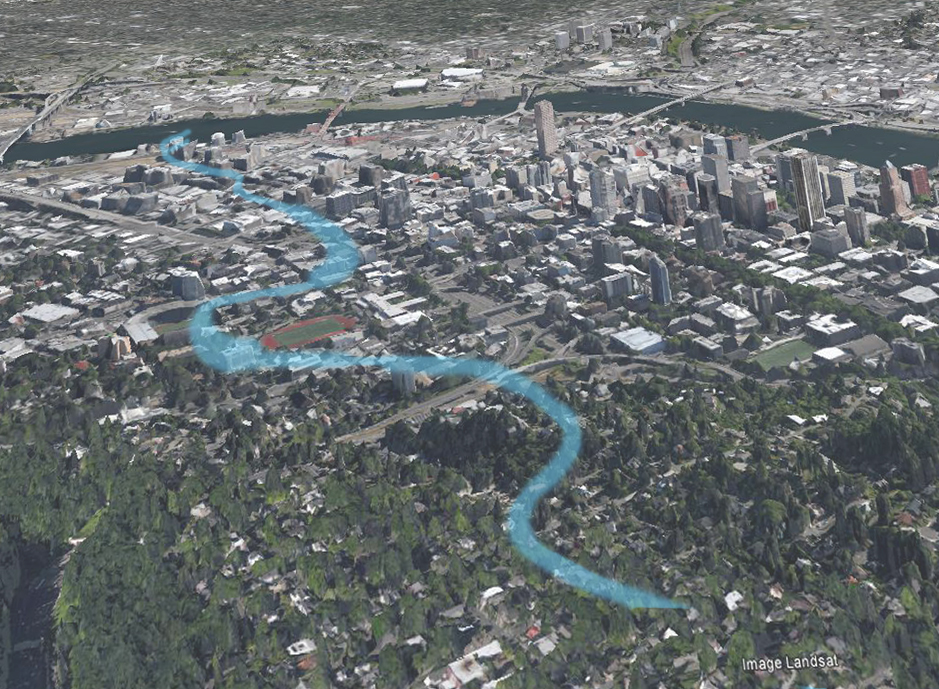Originally published on Terra Fluxus – 01/15/2011
As I mentioned in the previous post, there have been a number of inspirations that led to the current work on the Hidden Hydrology of Portland. I will take this week outlining a few of the past words and images that have led to the current work. A seminal work, by Anne Whiston Spirn, is part of the great book ‘The Language of Landscape‘. This particular text was adapted into a short prose piece in Arcade Journal – although I can’t seem to find the exact issue (so anyone who knows give me a heads up).
The imagery has stayed with me, and the resonance is echoed by Spirn in a different quote in the book about the revelatory power in searching for and expressing hidden hydrology: “Revealing the presence of the buried creek is an important part of the proposal because many who live here do not even know the creek exists despite its persistent influence on their lives.” (Spirn, 2000: p.213)
The Yellowwood and the Forgotten Creek
…One day the street caved in.
Sidewalks collapsed into a block-long chasm.
People looked down, shocked to see a strong, brown, rushing river.
A truck fell into a hole like that years back,
Someone said. A whole block of homes fell in
One night a long time ago, said someone else.
They weren’t sure where.
Six months later, the hole was filled, street patched,
Sidewalks rebuilt. Years went by, people left, new folks moved in,
Water seeped, streets dipped, walls cracked.
Once a creek flowed—long before there was anyone to give it a name–coursing
Down, carving, plunging, pooling, thousands of years
Before dams harnessed its power,
Before people buried it in a sewer and built houses on top.
Now, swollen with rain and sewage, the buried creek bursts pipes, soaks soil, floods basements,
Undermines buildings. During storms brown water gushes from inlets and manholes into streets and,
Downstream, overwhelms the sewage treatment plant, overflowing into the river from which the city
Draws its water…
…Signs of hope, signs of warning are all around, unseen,
Unheard, undetected. Most people can no longer read the signs whether they live in a floodplain,
Whether they are rebuilding a neighborhood or planting the seeds of its destruction,
Whether they are protecting or polluting the water they drink,
Caring for or killing a tree.
Architects’ drawings show no roots,
No growing, just green lollipops and buildings floating on a page, as if ground were flat and blank,
The tree an object, not a life.
Planners’ maps show no buried rivers, no flowing, just streets, lines of ownership, and
Proposals for future use, as if past were not present, as if the city were merely a human construct,
Not a living, changing landscape…
…Humans are story-telling animals, thinking in metaphors steeped in landscape:
Putting down roots means commitment,
Uprooting, a traumatic event.
Like a living tree rooted in place,
Language is rooted in landscape. Imagining
New ways of living means relearning the language
Which roots life in place.
The meanings landscapes hold are
Not just metaphorical and metaphysical,
But real, their messages practical;
understanding may spell survival or extinction.
Losing or failing to hear and read
the language of landscape threatens body and spirit, for the pragmatic
and imaginative aspects of landscape language
have always coexisted.
Relearning the language that holds
Life in place is an urgent task.
My work is dedicated to its recovery
And renewal.





5 thoughts on “Hidden Hydrology Origins 1: The Yellowwood and the Forgotten Creek”